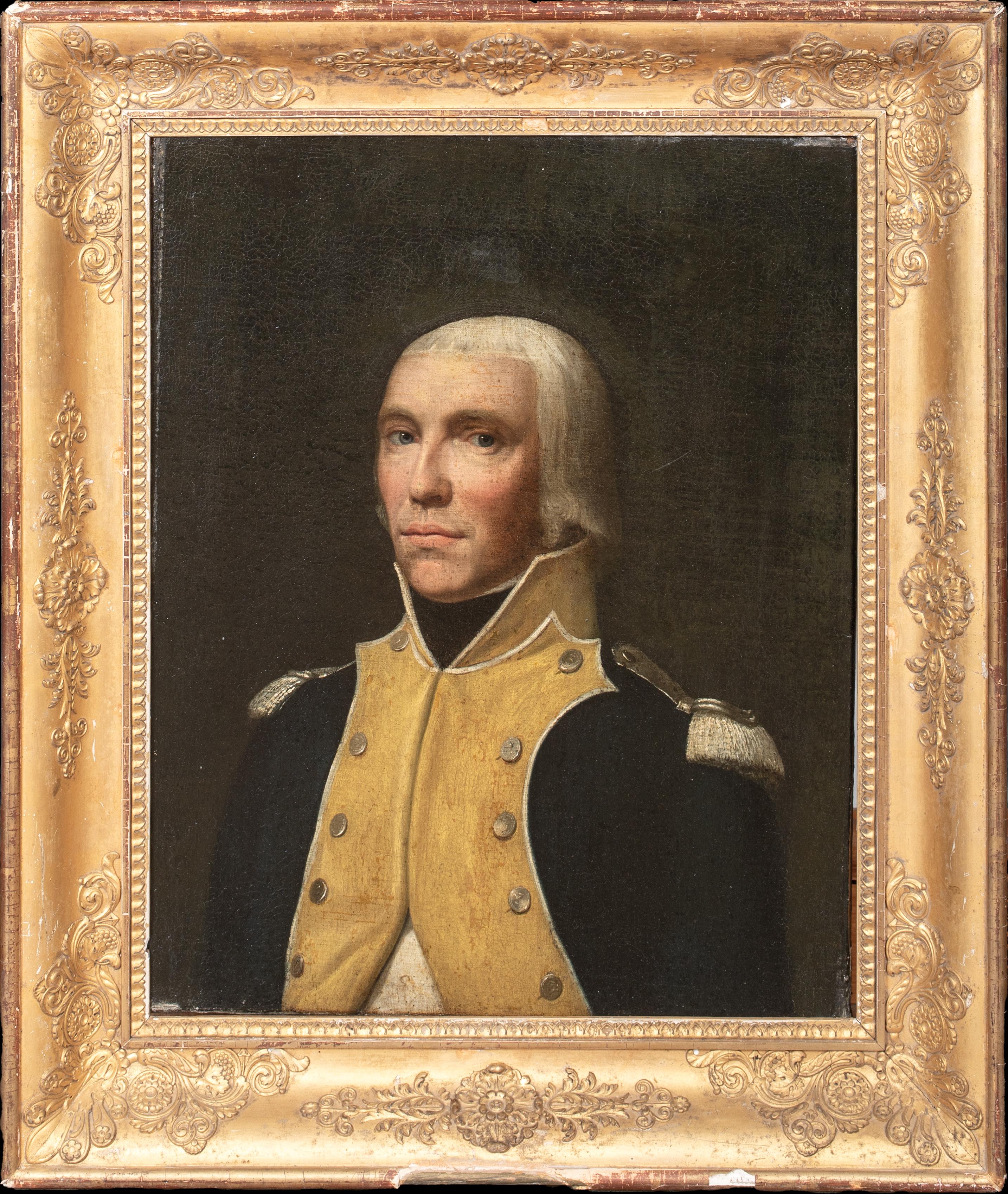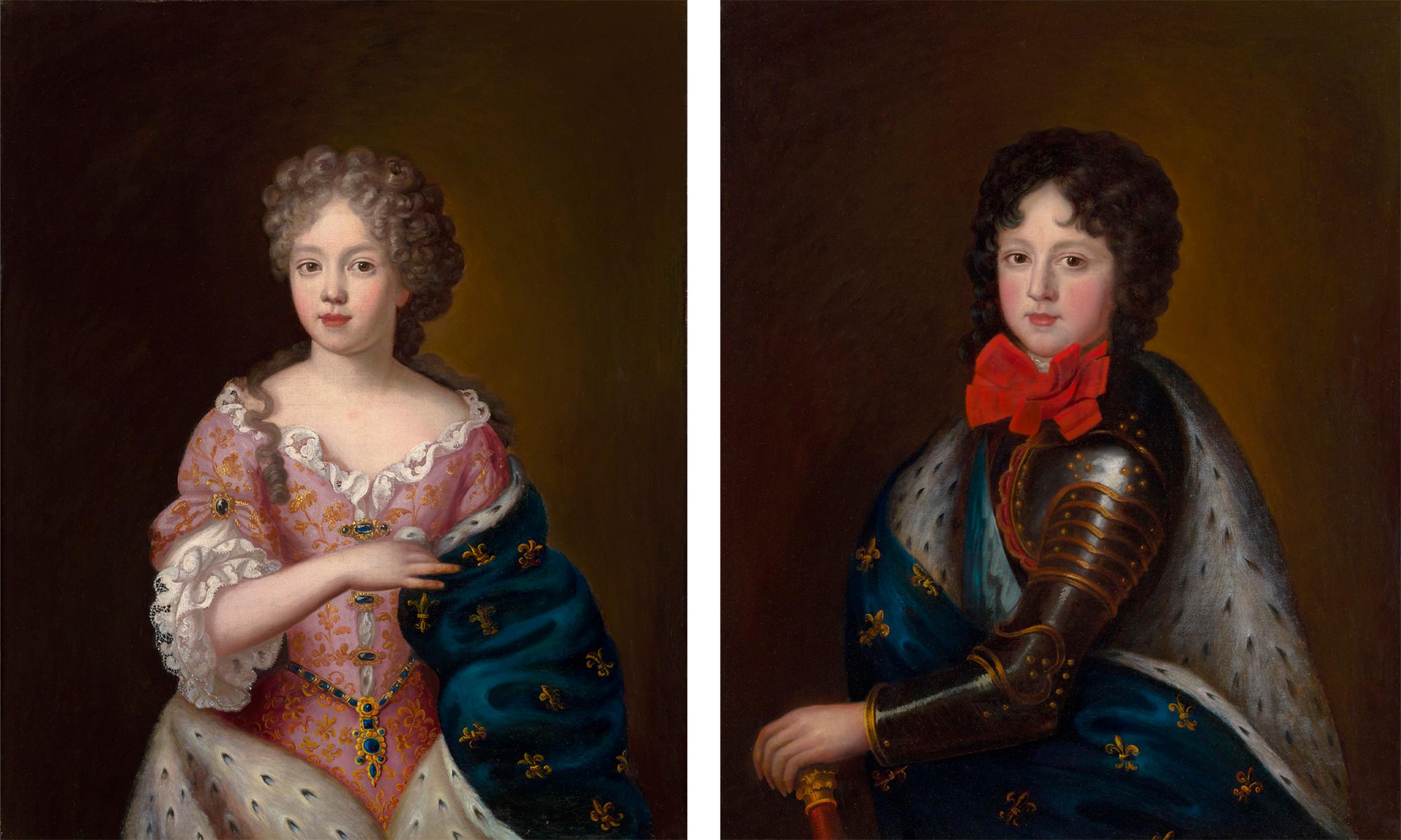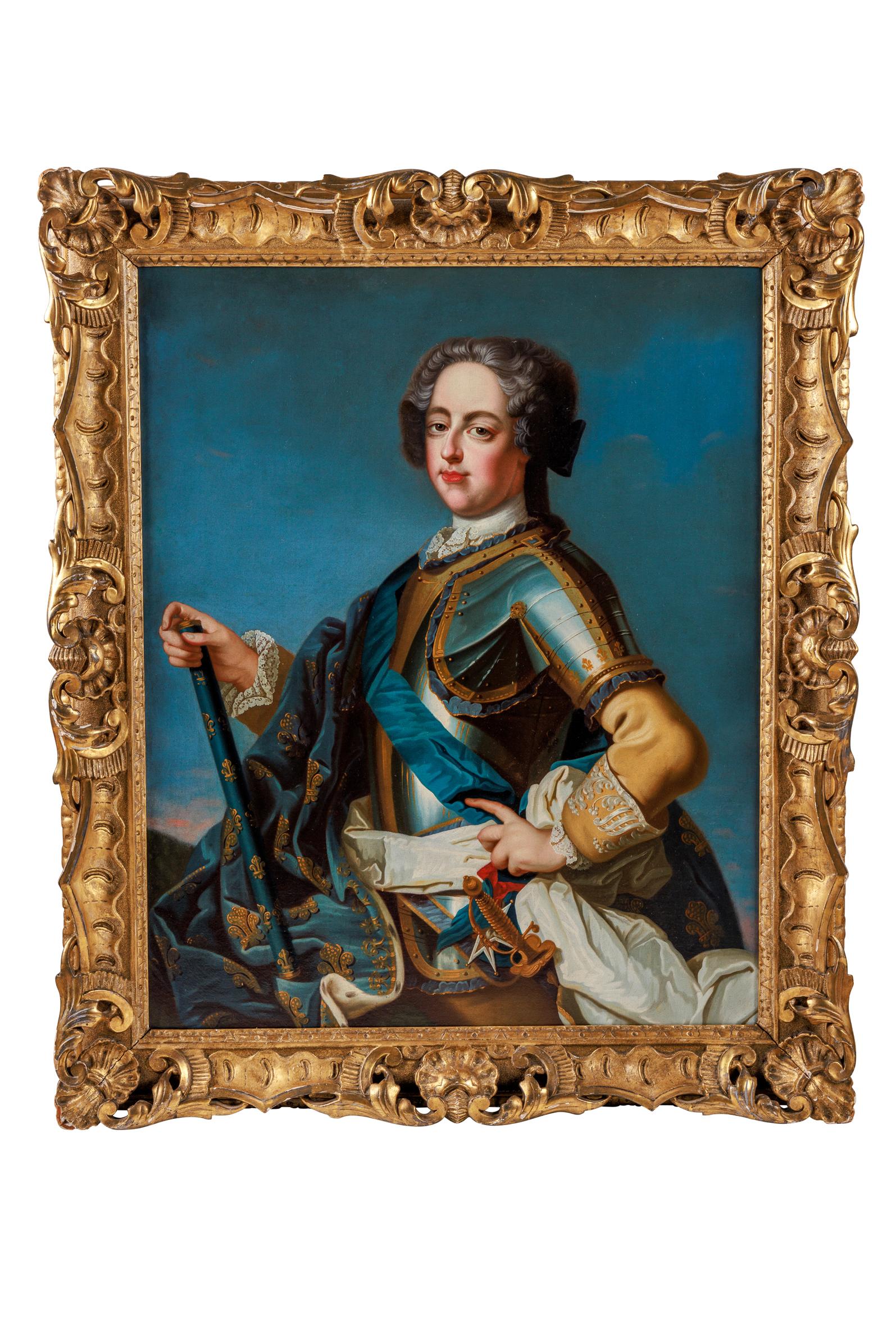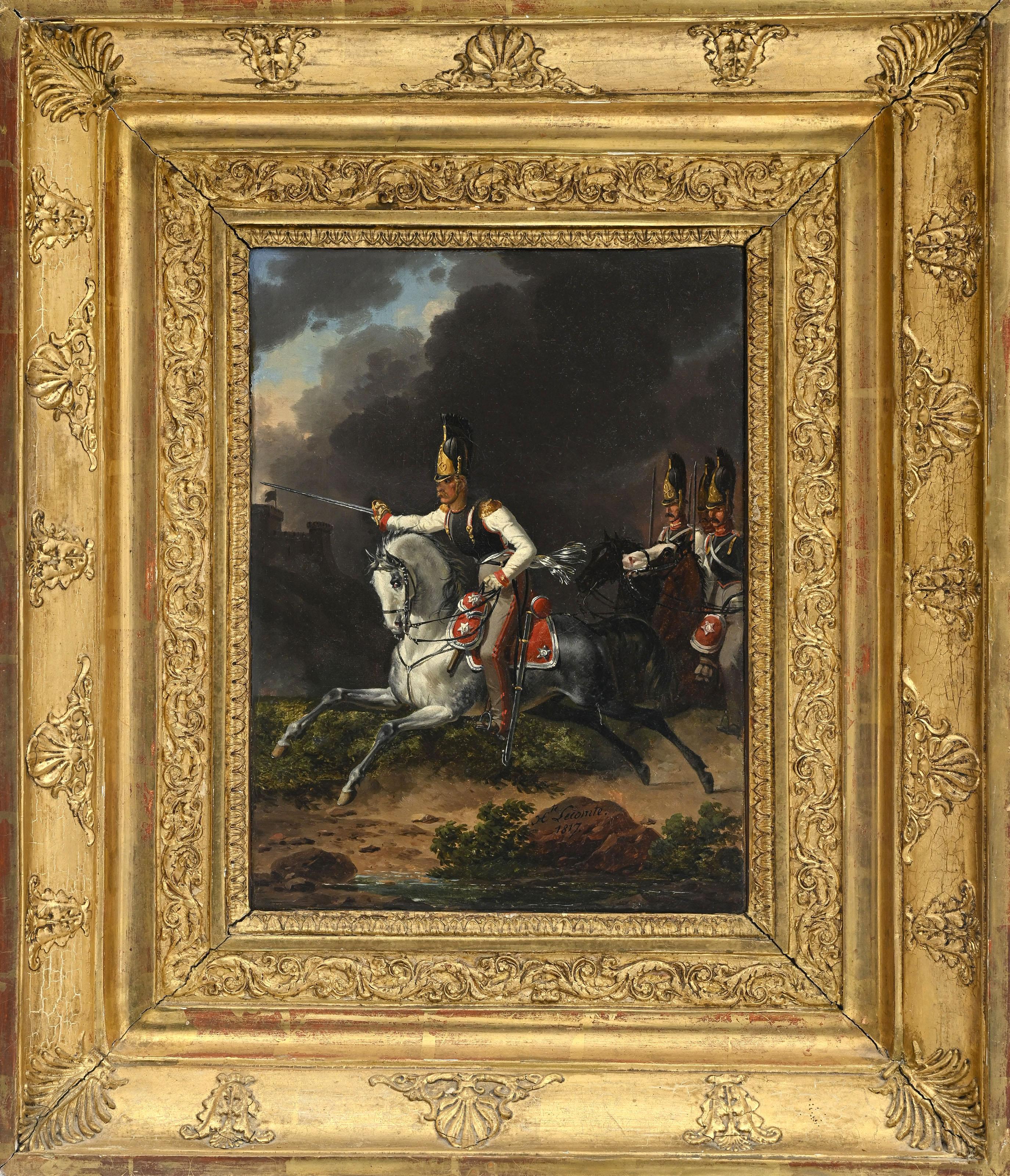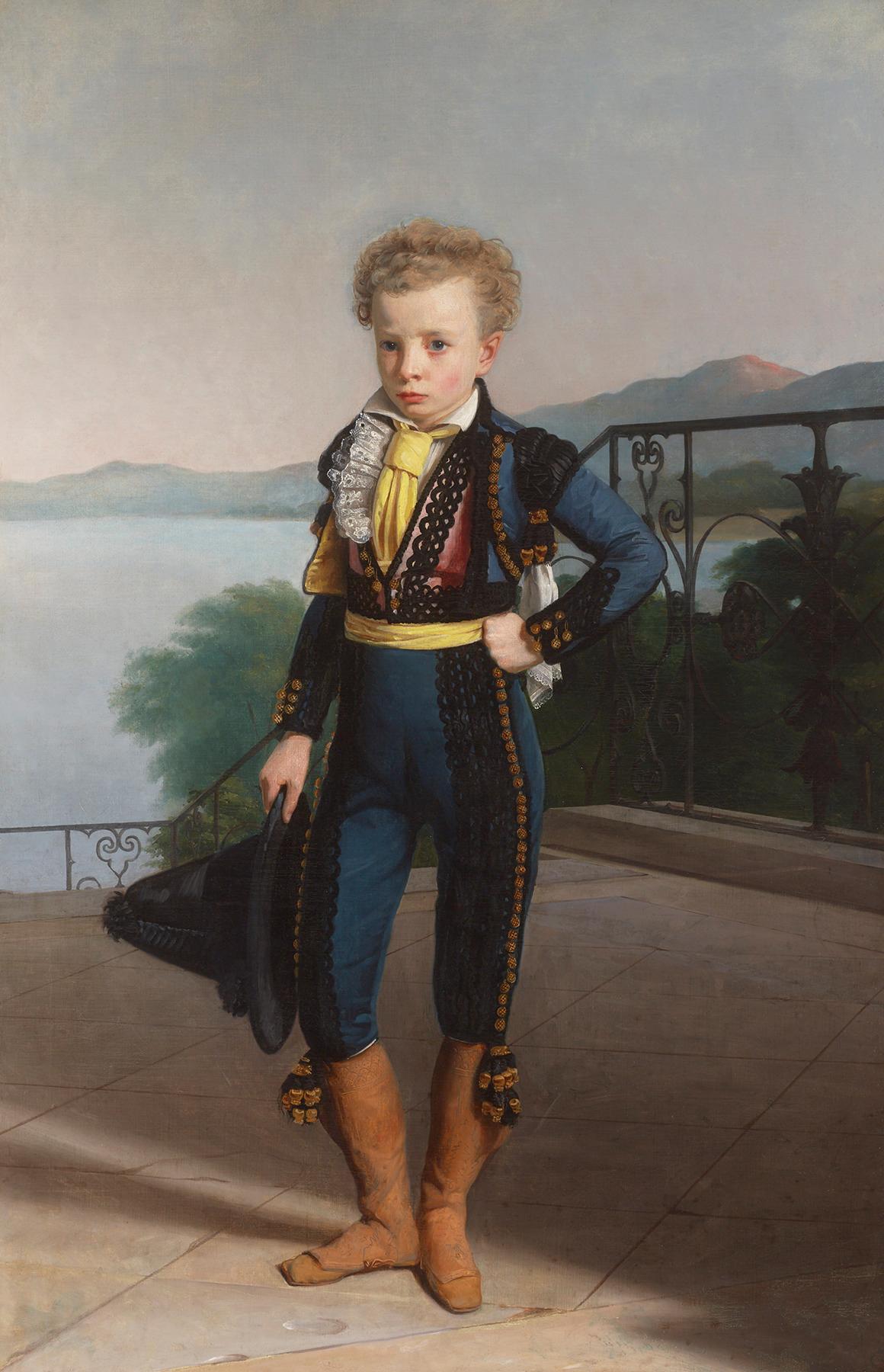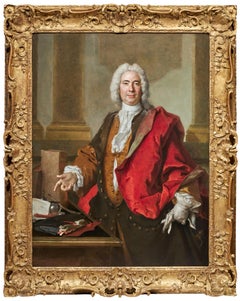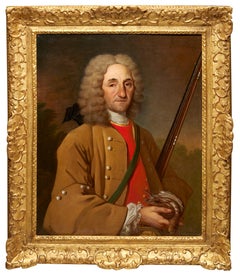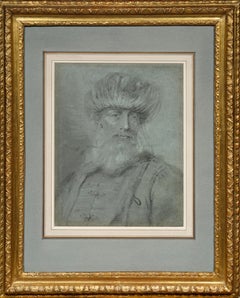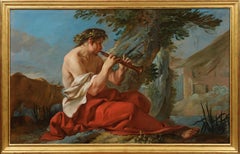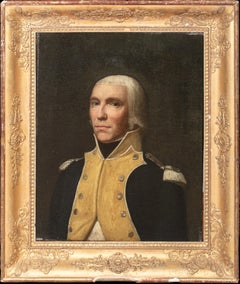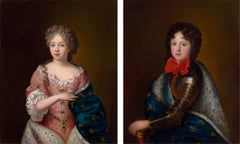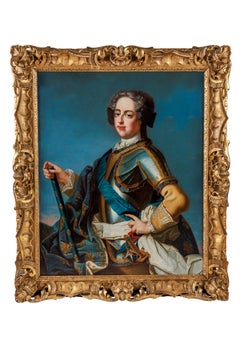Items Similar to Two royal portraits (the Duc d'Angoulême and the Duc de Berry) by H.P. Danloux
Want more images or videos?
Request additional images or videos from the seller
1 of 13
Henri-Pierre DanlouxTwo royal portraits (the Duc d'Angoulême and the Duc de Berry) by H.P. Danloux1797
1797
$80,000
£60,407.42
€70,085.02
CA$112,425.13
A$125,257.47
CHF 65,390.32
MX$1,520,792.58
NOK 821,913.72
SEK 776,908.13
DKK 523,176.20
About the Item
These two royal portraits are a major historical testimony to the stay of the Comte d'Artois (the future Charles X) and his family in Edinburgh in 1796-1797. Given by the sitters to Lord Adam Gordon, the Governor of Edinburgh, and kept by family descent to this day, these two portraits provide us with a vivid and spontaneous image of the Duc d’Angoulême and his brother the Duc de Berry. Danloux, who had emigrated to London a few years before, demonstrate his full assimilation of the art of British portrait painters in the brilliant execution of these portraits.
1. Henri-Pierre Danloux, a portraitist in the revolutionary turmoil
Born in Paris in 1753, Henri-Pierre Danloux was first a pupil of the painter Nicolas-Bernard Lépicié (1735 - 1784) and then, in 1773, of Joseph-Marie Vien (1716 - 1809), whom he followed to Rome when, at the end of 1775, Vien became Director of the Académie de France. In Rome he became friends with the painter Jacques-Louis David (1748 - 1825).
Returning to France around 1782, he settled in Lyon for a few years before returning to Paris in 1785. One of his first portraits was commissioned by the Baroness d'Etigny, the widow of the former Intendant of the Provinces of Gascony, Bearn and Navarre Antoine Mégret d'Etigny (1719 – 1767). He then became close to his two sons, Mégret de Sérilly and Mégret d'Etigny, who in turn became his patrons. In 1787, this close relationship with the d'Etigny family was further strengthened by his marriage to Antoinette de Saint-Redan, a relative of Madame d'Etigny. After his marriage, he left for Rome and did not return to France until 1789. It was during the winter of 1790-1791 that he painted one of his masterpieces, the portrait of Baron de Besenval. Set in a twilight atmosphere, this portrait of an aristocrat who knows that his death is imminent symbolizes the disappearance of an erudite and refined society which would be swept away by the French Revolution.
The Jacobin excesses led Danloux to emigrate to England in 1792; many members of his family-in-law who remained in France were guillotined on 10 May 1794. Danloux enjoyed great success as a portrait painter in England before returning to France in 1801.
During his stay in England, Danloux was deeply under the influence of English portraitists: his colors became warmer (as shown by the portrait of the Duc d'Angoulême that we are presenting), and his execution broader.
2. Description of the two portraits and biographical details of the sitters
The Duc d'Angoulême (1775-1844) was the eldest son of the Comte d'Artois, the younger brother of King Louis XVI (the future King Charles X), and his wife Marie-Thérèse of Savoie. He is shown here, in the freshness of his youth, wearing the uniform of colonel-general of the "Angoulême-Dragons" regiment.
He is wearing the blue cordon of the Order of the Holy Spirit, which was awarded to him in 1787, and two decorations: the Cross of Saint-Louis and the Maltese Cross, as he was also Grand Prior of the Order of Malta.
Born on 16 August 1775 in Versailles, Louis-Antoine d'Artois followed his parents into emigration on 16 July 1789. In 1792, he joined the émigrés’ army led by the Prince de Condé. After his stay in Edinburgh (which will be further discussed), he went to the court of the future King Louis XVIII, who was in exile at the time, and in 1799 married his first cousin Marie-Thérèse Charlotte of France, the daughter of Louis XVI and the sole survivor of the royal family. The couple had no descendants. He became Dauphin of France in 1824, upon the accession to the throne of his father but played only a minor political role, preferring his military position as Grand Admiral. Enlisted in Spain on the side of Ferdinand VII, he returned home crowned with glory after his victory at Trocadero in 1823.
He reigned for a very short time at the abdication of Charles X in 1830, before relinquishing his rights in favor of his nephew Henri d'Artois, the Duc de Bordeaux. He then followed his father into exile and died on 3 June 1844 in Gorizia (now in Italy).
His younger brother, the Duc de Berry, is shown in the uniform of the noble cavalry of the émigrés’ Army. He is wearing the blue cordon of the Order of the Holy Spirit, awarded to him in May 1789, and the Cross of Saint-Louis (partly hidden by his blue cordon).
Born on 24 January 1778 in Versailles, Charles-Ferdinand d'Artois also followed his parents into emigration and joined the émigrés’ army in 1792. After his stay in Edinburgh, he remained in Great Britain, where he had an affair with Amy Brown, who gave him two daughters that he entrusted to the Duc de Coigny on his return to France during the First Restoration. In 1816 he married Marie-Caroline de Bourbon, Princess of the Two Sicilies (a granddaughter of King Ferdinand 1er of the Two Sicilies and Queen Marie-Caroline, herself the sister of Queen Marie-Antoinette), born in 1798.
On 13 February 1820, the Duc de Berry met a tragic end : he was stabbed by Louis Pierre Louvel, a Bonapartist worker, as he was leaving the opera house on rue Richelieu. The building was demolished by order of Louis XVIII, and the area, which has been left undeveloped, is now known as Square Louvois. His wife, who was pregnant at the time of his death, gave birth seven months later to Henri d'Artois, the Duc de Bordeaux. Called "the miracle child" by Lamartine, he had no descendants, putting an end to the Artois branch of the Bourbon family.
3. Danloux's stay in Edinburgh
The Baron Portalis' book, published in 1910, provides us with some details of Danloux's British sojourn based upon numerous extracts from his diary.
On 13 June 1796, Danloux received the visit in his London studio of the Comte de Damas, who delivered him a letter from Madame de Polastron asking him to come and paint the Comte d’Artois in Edinburgh. On 13 September he left for Scotland. Upon his arrival in Edinburgh, Danloux painted first a portrait of the Comte d’Artois (7th photo in the gallery). The Comte d’Artois had moved to the Holyrood Palace at the suggestion of the British government, in order to benefit from a place where he could escape his creditors, as he was unable to pay the debts he had incurred to support the monarchical cause, and in particular Condé's army.
The Comte d'Artois was soon joined by a small court of loyal courtiers led by Louise de Polastron, his long-time mistress. After the portrait of the Comte d'Artois - who was very pleased with it - Danloux tackled that of his eldest son, the Duc d'Angoulême (which was already completed on 27 September, according to his diary). These two canvases are in a small format that the artist was particularly fond of. He then produced two replicas of these two portraits, intended to be given to some friends of the prince.
Letters from his wife testify to the artist's genuine satisfaction after the completion of these two portraits: "He tells me that he has finished the portrait of M. le Duc d'Angoulême, which is as good as that of his father. He had a sort of small triumph: Monsieur, when dining one day at Lord Adam Gordon's, the Governor of Edinburgh, sent for his portrait after dinner, and then called my husband. When he arrived, Lord Adam met him, apologised profusely for not having invited him and drank with him for two hours”.
Each courtier wanted in turn to have his portrait painted by Danloux. But these successes did not convince Danloux of the quality of this small court, as he wrote in a letter "the prince is good but weak andin a very bad company. His son is a fool, stupid and stubborn, and all those present are a bunch of courtiers...".
During his stay in Edinburgh, Danloux also encountered the third Duke of Buccleugh, who lived a few miles away at Dalkeith Castle, which he visited on 10 November 1796. This visit led to the commission of one of the artist's masterpieces, which required him to spend a large part of the winter at Dalkeith: a large portrait depicting the whole family in the park, in the manner of English conversation pieces.
4. Lord Adam Gordon (circa 1726 - 1801)
Lord Adam Gordon, appointed (military) Governor of Edinburgh in 1796, resided with several Scottish families at the Holyrood Palace. He was responsible for welcoming the Comte d’Artois and his sons on their arrival in Edinburgh. He was the fourth son of the second Duke of Gordon. Portalis describes him as a bon vivant and a great hunter. He commissioned Danloux to paint his own portrait during his stay in Edinburgh, which is now in the National Galleries of Scotland.
5. Related artworks
The Comte d'Artois left Edinburgh to settle in London in 1799. It is not possible to know for certain whether Danloux returned to Edinburgh after his stay in Dalkeith, and painted there the replicas of the portraits or whether some of them were executed after his return to London.
However, it seems certain that, as indicated in the two cartouches, our two paintings were given to Lord Adam Gordon by the two young princes in Edinburgh, perhaps at the Duc d'Angoulême's departure?
These two portraits are slightly different in size, one being oval (the Duc d'Angoulême) and the other rectangular (the Duc de Berry). We do not know whether the oval format corresponds to the original format of the portrait of the Duc d'Angoulême, or whether the canvas has been cut to be presented as a medallion. The frames were probably commissioned by Lord Adam Gordon to form a pair, even though the choice of an oval medallion hides the Duc de Berry’s armband.
We know that there were at least three versions of the portrait of the Duc d'Angoulême, but we have only found another one, which is kept (along with the portrait of the Duc de Berry) at the Château de Versailles (8th and 9th photo in the gallery). These two portraits are identical in size (27.2 x 21.9 cm), just slightly larger than our portrait of the Duc de Berry (26.5 x 21 cm).
While the portrait of the Duc de Berry is fairly similar to the one we are presenting, that of his eldest brother seems less spontaneous and less lively, as it lacks the cloudy background we have here.
Main bibliographical references :
Baron Roger Portalis – Henry-Pierre Danloux peintre de portraits Son journal durant l’Emigration – Paris Edouard Rahir 1910
Catalogue de l’exposition « la duchesse d’Angoulême et le duc d’Angoulême » tenue à la chapelle expiatoire du 22 avril au 17 septembre 2023
Patrick Spilliaert - Les insignes de l’ordre du Saint-Esprit - Editions du Léopard d’or
- Creator:Henri-Pierre Danloux (1753 - 1809, French)
- Creation Year:1797
- Dimensions:Height: 14 in (35.56 cm)Width: 11.8 in (29.98 cm)
- Medium:
- Movement & Style:
- Period:1790-1799
- Condition:The canvas depicting the Duc d'Angoulême is signed "HP Danloux 1797". Provenance : given to Lord Adam Gordon by the sitters and then by family descent.
- Gallery Location:PARIS, FR
- Reference Number:1stDibs: LU1568212592382
About the Seller
5.0
Vetted Professional Seller
Every seller passes strict standards for authenticity and reliability
Established in 2020
1stDibs seller since 2021
10 sales on 1stDibs
Typical response time: 3 hours
- ShippingRetrieving quote...Shipping from: PARIS, France
- Return Policy
Authenticity Guarantee
In the unlikely event there’s an issue with an item’s authenticity, contact us within 1 year for a full refund. DetailsMoney-Back Guarantee
If your item is not as described, is damaged in transit, or does not arrive, contact us within 7 days for a full refund. Details24-Hour Cancellation
You have a 24-hour grace period in which to reconsider your purchase, with no questions asked.Vetted Professional Sellers
Our world-class sellers must adhere to strict standards for service and quality, maintaining the integrity of our listings.Price-Match Guarantee
If you find that a seller listed the same item for a lower price elsewhere, we’ll match it.Trusted Global Delivery
Our best-in-class carrier network provides specialized shipping options worldwide, including custom delivery.More From This Seller
View AllPortrait of Monsieur Aubert, a ceremonial portrait by Nicolas de Largillière
By Nicolas de Largillière
Located in PARIS, FR
Provenance :
Arnold S. Kirkeby (1901-1962)
Donated by Arnold S. Kirkeby to the Los Angeles County Museum of Art in 1955, where it remained until its sale at Sotheby's, New York on Ja...
Category
1720s Old Masters Portrait Paintings
Materials
Oil
Portrait of Julien Prieur the bailiff of the Marquis d'Armentières as a Hunter
By Jean-Baptiste Oudry
Located in PARIS, FR
This portrait depicts us the trusted confidant of the Conflans d'Armentières family. More precisely, Julien Prieur was the fiscal procurator of the Marquisate of Armentières, playing...
Category
1730s Old Masters Portrait Paintings
Materials
Canvas, Oil
Portrait of an Ottoman Dignitary, a drawing by Giuseppe Nogari (ca. 1760)
Located in PARIS, FR
We would like to thank Mrs. Bozena Anna Kowalczyk for confirming the attribution of this drawing to Giuseppe Nogari in a study (available in Italian) from which we have taken our ins...
Category
1760s Old Masters Portrait Drawings and Watercolors
Materials
Laid Paper, Chalk
Mercury and Io, a rediscovered painting by Jean-Baptiste Marie Pierre (ca. 1740)
Located in PARIS, FR
We would like to thank Mr. Nicolas Lesur for confirming the autograph nature of the entire composition after a direct examination of the painting on November 27, 2024.
This painting...
Category
1740s Old Masters Figurative Paintings
Materials
Canvas, Oil
Allegory of the Treaty of Angoulême, a drawing attributed to Donato Mascagni
Located in PARIS, FR
We would like to thank Mrs. Ursula Verena Fischer Pace for suggesting the attribution to Donato Arsenio Mascagni.
We were immediately seduced by the rich tonalities of this allegory...
Category
1620s Old Masters Figurative Drawings and Watercolors
Materials
Ink
Three drawings by François Boucher in a mounting by Jean-Baptiste Glomy
By François Boucher
Located in PARIS, FR
We would like to thank Juliette Parmentier-Courreau of the Custodia Foundation for her welcome and support during the consultation of Glomy’s Journal des Ouvrages.
This spectacularly large "feuille de desseins ajustés" commissioned by François Boucher from Jean-Baptiste Glomy is emblematic of the painter's art and mastery of rocaille. It is also fully representative of the taste of this period in the field of decorative arts. The largest of these three drawings, placed at the bottom of the composition, is particularly interesting: dating from around 1756, it constitutes a modello (apparently unpublished) for the frontispiece of the "Catalogue des tableaux de Monsieur de Julienne"), preserved in the Morgan Library in New York.
1. François Boucher, the master of French rocaille
The extraordinary career of Francois Boucher was unmatched by his contemporaries in versatility, consistency and output. For many, particularly the writers and collectors who led the revival of interest in the French rococo during the last century, his sensuous beauties and plump cupids represent the French eighteenth century at its most typical. His facility with the brush, even when betraying the occasional superficiality of his art, enabled him to master every aspect of painting – history and mythology, portraiture, landscape, ordinary life and, as part of larger compositions, even still life. He had been trained as an engraver, and the skills of a draftsman, which he imbued in the studio of Jean-Francois Cars (1661 – 1738), stood him in good stead throughout his career; his delightful drawings are one of the most sought-after aspects of his oeuvre.
As a student of Francois Lemoyne (1688 - 1737), he mastered the art of composition. The four years he spent in Italy, from 1727-1731, educated him in the works of the masters, classics and history, that his modest upbringing had denied him.
On his return to Paris in 1734, he gained full membership of the Royal Academy of Painting and Sculpture with his splendid Rinaldo and Armida (Paris, Musée du Louvre). Although, throughout his career, he occasionally painted subjects taken from the Bible, and would always have considered himself first as a history painter, his own repertoire of heroines, seductresses, flirtatious peasant girls and erotic beauties was better suited to a lighter, more decorative subject matter. His mastery of technique and composition enabled him to move from large scale tapestry...
Category
1750s Old Masters Figurative Drawings and Watercolors
Materials
Chalk, Ink
You May Also Like
Portrait of Colonel Charles-Louis-Prosper Marquis de Chérisey (1786-1837)
Located in Paris, IDF
After Louis-Stanislas MARIN-LAVIGNE (Paris, 1797 – Paris, 1860)
Portrait of Colonel Charles-Louis-Prosper Marquis de Chérisey (1786-1837)
in the uniform of commander of the 38th lin...
Category
Mid-19th Century French School Portrait Paintings
Materials
Oil
Portrait Of Marshal Jean-Baptiste Bessières, Duc d'Istrie (1768-1813), Napoleon
Located in Blackwater, GB
Portrait Of Marshal Jean-Baptiste Bessières, Duc d'Istrie (1768-1813), circa 1810
French School
Large circa 1810 portrait of Marshal Jean-Baptiste Bessières, Duc d'Istrie, oil on c...
Category
Early 19th Century Portrait Paintings
Materials
Oil, Canvas
$4,850 Sale Price
20% Off
Pair of Royal Portraits of the Duke and Duchess of Burgundy
By Pierre Gobert
Located in New Orleans, LA
Follower of Pierre Gobert
18th century French
The Duke and Duchess of Burgundy
Oil on canvas
Refinement and intricacy characterize these royal portra...
Category
18th Century Portrait Paintings
Materials
Canvas, Oil
After Jean-Baptiste Van Loo, Portrait of King Louis XV of France (1710-1774)
Located in Queens, NY
After Jean-Baptiste Van Loo, A Portrait of King Louis XV of France (1710-1774)
A magnificent quality three-quarter length portrait of King Louis XV of France and Navarre, painted in the 18th century after Jean-Baptiste Van Loo.
Oil on canvas, in the original carved and gilt wood frame.
Canvas: 40" high x 32" wide
Frame: 46.5" high x 39" wide
Very good condition, ready to hang. No damages noted.
The present composition follows a portrait of Louis XV painted by Jean-Baptiste Van Loo in 1726-1727, today in Versailles. (Oil on canvas. 198.5 by 143 cm. Inv. no. MV 6942.)
There were several full-length portraits painted by Van Loo of the young Louis XV, and all were executed in the years of or after his majority, 1723, when he took full control of government, wresting power from the Régent, his great-uncle Philippe, Duc d'Orléans. A slightly larger version (205 by 171 cm), in which the pose and surrounding paraphernalia mirrors that of the present work, is in the Château de Versailles, while another, in which Louis stands more front-on, his pointing right index-finger now tucked in, and with a different background arrangement, is also in Versailles. Further versions of this latter are in Nice, Musée Chéret and the Musée de Perpignan.
The composition of all of these full-lengths would appear to derive from Van Loo's large equestrian portrait of Louis XV, painted in collaboration with Charles Parrocel, which was commissioned in 1723 by the Surintendance for Charles de Lorraine. Louis is depicted in similar armour and costume, astride his horse, similarly turned three-quarters to the left and his right arm outstretched. Most subsequent depictions of Louis followed this original design, including, for example, Carle Van...
Category
18th Century Portrait Paintings
Materials
Oil, Canvas
Portrait of Russian cuirassiers colonel
By Hippolyte Lecomte
Located in BELEYMAS, FR
Hippolyte LECOMTE
(Puiseaux, 1781 – Paris, 1857)
Colonel of Russian cuirassiers
Oil on canvas
H. 33 cm; W. 24 cm
Signed and dated at the bottom towards the center 1817
Exhibition: S...
Category
1810s French School Animal Paintings
Materials
Oil, Canvas
Portrait of Napoléon II
Located in New Orleans, LA
The son of the legendary Napoléon Bonaparte, Napoléon François Charles Joseph, takes a spirited stance in this remarkable oil painting attributed to the Austrian portraitist Johann Peter Krafft. Believed to have been exhibited at the Exposition Universelle of 1900 in Paris, this work stands as a testament to both Austrian artistry and the legacy of one of the most powerful men in history.
After Napoléon's exile to the island of Elba in 1814, his son was seen by many of his supporters as the last hope of France. The child was named the ruler of half of Europe, holding the titles of Napoléon II...
Category
Early 19th Century Academic Portrait Paintings
Materials
Canvas, Oil
